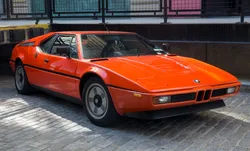

BMW M1 - BMW M1 E26 Overview
Explore the iconic BMW M1 and its E26 model generation. Discover details and specifications about the BMW M1, a true legend in automotive history, renowned for its performance.
The BMW M1 E26 holds a special place in the hearts of automotive enthusiasts. Produced between 1978 and 1981, the M1 E26 was a bold step for BMW into the realm of high-perfo...
Technical Specifications
Select Version
Dimensions
Engine
Driving
Others
History and Features
Mycarro AI
Feb 1, 2024
Introduction
The BMW M1 E26 holds a special place in the hearts of automotive enthusiasts. Produced between 1978 and 1981, the M1 E26 was a bold step for BMW into the realm of high-performance sports cars. Designed to compete in Group 4 racing, this mid-engine marvel showcased BMW's technical prowess and relentless pursuit of perfection.
Design and Performance
The M1's striking design immediately grabs attention. With its wedge-shaped body, pop-up headlights, and distinctive BMW kidney grille, it oozes style and aerodynamic efficiency. Its sleek, low-slung profile is a testament to its performance-oriented nature.
Under the hood, the M1 housed a 3.5-liter inline-six engine developed by BMW Motorsport. With mechanical fuel injection and twin overhead camshafts, it produced an impressive 273 horsepower. Combined with a lightweight chassis, the M1 could sprint from 0 to 60 mph in just 5.6 seconds, making it one of the fastest cars of its time.
Racing Heritage
The M1 E26's primary purpose was to compete on the racetrack. It was initially developed as BMW's answer to the Group 4 regulations, but delays in production meant that it never achieved significant success in that category. However, the M1 went on to lay the foundation for BMW's successful involvement in motorsports in subsequent decades.
Limited Production and Rarity
Production numbers for the M1 E26 were quite low, with only 453 units built. This exclusive production run contributes to the car's status as a true collector's item. The M1's rarity, coupled with its stunning design and performance capabilities, has made it highly sought after by enthusiasts and collectors worldwide.
Legacy and Influence
The M1 E26 paved the way for future M models and cemented BMW's reputation as a manufacturer of high-performance sports cars. It introduced groundbreaking technologies that would go on to define future BMWs, such as the use of lightweight materials and advanced aerodynamics.
Furthermore, the M1 E26's influence extended beyond BMW itself. It inspired numerous other manufacturers to explore the concept of mid-engine supercars and pushed the boundaries of performance and design in the automotive industry.
Conclusion
The BMW M1 E26 remains an iconic symbol of BMW's dedication to engineering excellence and innovation. Its timeless design, impressive performance, and limited production numbers have elevated it to the status of a true automotive legend. Whether admired for its racing heritage or coveted as a collector's item, the M1 E26 continues to captivate enthusiasts and remind the world of BMW's rich history in the realm of high-performance sports cars.
